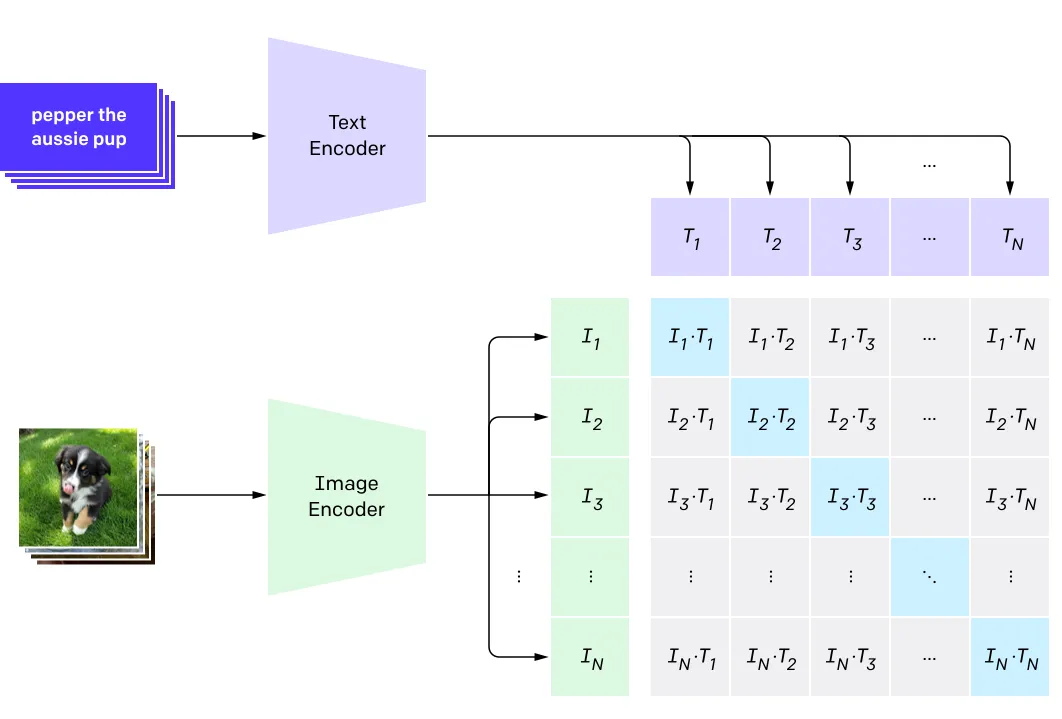使用Openvino加速矢量搜索应用程序
在本文中,我们使用 OpenAI 的 CLIP 进行文本到图像和图像到图像的搜索,并将在速度提升方面对比分析 PyTorch 模型、FP16 OpenVINO 格式和 INT8 OpenVINO 格式。
OpenAI的CLIP
CLIP是一个能够同时处理图像和文本的神经网络。
CLIP 是一个多模态模型,这意味着它能理解文本和图像输入。它还意味着它可以将输入嵌入到一个多模态空间中,在这个空间里,无论其类型如何,图像和文本都位于语义上有意义的位置。
下面的图片展示了预训练过程的可视化。

英特尔OpenVINO
OpenVINO工具包是一个免费的工具包,它便于从框架中优化深度学习模型,并将推理引擎部署到英特尔硬件上。我们将使用OpenVINO CLIP模型,采用FP16和INT8格式。

本文使用OpenVINO来加速LanceDB嵌入管道。
实现
在实现部分,我们看到了使用概念标题数据集的Hugging Face 和OpenVINO格式的CLIP模型的比较实现。
我们从第一步开始,从Hugging Face中加载概念标题数据集。
# https://huggingface.co/datasets/conceptual_captions
image_data = load_dataset(
"conceptual_captions", split="train",
)
我们将从大量的图像中选择100个图像作为样本
#taking first 100 images
image_data_df = pd.DataFrame(image_data[:100])
辅助函数用于验证图像URL并从图像URL获取图像和标题
def check_valid_URLs(image_URL):
"""
Not all the URLs are valid. This function returns True if the URL is valid. False otherwise.
"""
try:
response = requests.get(image_URL)
Image.open(BytesIO(response.content))
return True
except:
return False
def get_image(image_URL):
response = requests.get(image_URL)
image = Image.open(BytesIO(response.content)).convert("RGB")
return image
def get_image_caption(image_ID):
return image_data[image_ID]["caption"]
# Transform dataframe
image_data_df["is_valid"] = image_data_df["image_url"].apply(check_valid_URLs)
#removing all the in_valid URLs
image_data_df = image_data_df[image_data_df["is_valid"]==True]
image_data_df.head()
现在我们已经准备好了数据集,我们准备开始使用Hugging Face 和OpenVINO进行CLIP,并在速度方面对它们的性能进行比较分析。
Pytorch CLIP使用Hugging Face
我们将从使用Hugging Face的CLIP开始,并使用LanceDB矢量数据库提取嵌入和搜索所需的时间。
def get_model_info(model_ID, device):
"""
Loading CLIP from HuggingFace
"""
# Save the model to device
model = CLIPModel.from_pretrained(model_ID).to(device)
# Get the processor
processor = CLIPProcessor.from_pretrained(model_ID)
# Get the tokenizer
tokenizer = CLIPTokenizer.from_pretrained(model_ID)
# Return model, processor & tokenizer
return model, processor, tokenizer
# Set the device
device = "cuda" if torch.cuda.is_available() else "cpu"
model_ID = "openai/clip-vit-base-patch16"
model, processor, tokenizer = get_model_info(model_ID, device)
让我们编写一个辅助函数来提取文本和图像嵌入
def get_single_text_embedding(text):
# Get single text embeddings
inputs = tokenizer(text, return_tensors = "pt").to(device)
text_embeddings = model.get_text_features(**inputs)
# convert the embeddings to numpy array
embedding_as_np = text_embeddings.cpu().detach().numpy()
return embedding_as_np
def get_all_text_embeddings(df, text_col):
# Get all the text embeddings
df["text_embeddings"] = df[str(text_col)].apply(get_single_text_embedding)
return df
def get_single_image_embedding(my_image):
# Get single image embeddings
image = processor(
text = None,
images = my_image,
return_tensors="pt"
)["pixel_values"].to(device)
embedding = model.get_image_features(image)
# convert the embeddings to numpy array
embedding_as_np = embedding.cpu().detach().numpy()
return embedding_as_np
def get_all_images_embedding(df, img_column):
# Get all image embeddings
df["img_embeddings"] = df[str(img_column)].apply(get_single_image_embedding)
return df
连接LanceDB以存储提取的嵌入并进行搜索
import lancedb
db = lancedb.connect("./.lancedb")
使用CLIP Hugging Faces模型提取84张图片的嵌入表示,以及提取嵌入所需的时间。
import time
# extracting embeddings using Hugging Face
start_time = time.time()
image_data_df = get_all_images_embedding(image_data_df, "image")
print(f"Time Taken to Extracted Embeddings of {len(image_data_df)} Images(in seconds): ", time.time()-start_time)
结果:
Time Taken to Extracted Embeddings of 83 Images(in seconds): 65.51
将图像及其嵌入导入 LanceDB 以进行查询
def create_and_ingest(image_data_df, table_name):
"""
Create and Ingest Extracted Embeddings using Hugging Face
"""
image_url = image_data_df.image_url.tolist()
image_embeddings = [arr.astype(np.float32).tolist() for arr in image_data_df.img_embeddings.tolist()]
data = []
for i in range(len(image_url)):
temp = {}
temp['vector'] = image_embeddings[i][0]
temp['image'] = image_url[i]
data.append(temp)
# Create a Table
tbl = db.create_table(name= table_name, data=data, mode= "overwrite")
return tbl
#create and ingest embeddings for pt model
pt_tbl = create_and_ingest(image_data_df, "pt_table")
查询存储的嵌入表示
提取所有图片的嵌入表示所花费的时间,以及查询存储的嵌入表示
# Get the image embedding and query for each caption
pt_img_results = {}
start_time = time.time()
for i in range(len(image_data_df)):
img_query = image_data_df.iloc[i].image
query_embedding = get_single_image_embedding(img_query).tolist()
#querying with image
result = pt_tbl.search(query_embedding[0]).limit(4).to_list()
pt_img_results[str(i)] = result
print(f"Time taken to Extract Img embeddings and searching for {len(image_data_df)} images is ", time.time()-start_time)
结果:
Time taken to Extract Img embeddings and searching for 83 images is 72.34
使用 FP16 OpenVINO格式的CLIP 模型
现在我们将开始使用CLIP F16 OpenVINO格式,并记录提取嵌入向量以及将其导入到LanceDB向量数据库所需的时间。
!pip install -q --extra-index-url https://download.pytorch.org/whl/cpu gradio "openvino>=2023.2.0" "transformers[torch]>=4.30"
为将模型转换成OpenVINO格式并保存FP16 CLIP OpenVINO模型准备输入。
#inputs preparation for conversion and creating processor
text = image_data_df.iloc[10].caption
image = image_data_df.iloc[10].image
inputs = processor(text=[text], images=[image], return_tensors="pt", padding=True)
import openvino as ov
#saving openvino model
model.config.torchscript = True
ov_model = ov.convert_model(model, example_input=dict(inputs))
ov.save_model(ov_model, 'clip-vit-base-patch16.xml')
编译CLIP OpenVINO模型
import numpy as np
from scipy.special import softmax
from openvino.runtime import Core
"""
Compiling CLIP in Openvino FP16 format
"""
# create OpenVINO core object instance
core = Core()
# compile model for loading on device
compiled_model = core.compile_model(ov_model, device_name="AUTO", config={"PERFORMANCE_HINT": "CUMULATIVE_THROUGHPUT"})
# obtain output tensor for getting predictions
image_embeds = compiled_model.output(0)
logits_per_image_out = compiled_model.output(0)
image_url = image_data_df.image_url.tolist()
image_embeddings = []
def extract_openvino_embeddings(image_data_df):
"""
Extracting Image Embeddings using OpenVINO
"""
for i in range(len(image_data_df)):
image = image_data_df.iloc[i].image
inputs = processor(images=[image], return_tensors="np", padding=True)
image_embeddings.append(compiled_model(dict(inputs))["image_embeds"][0])
return image_embeddings
使用CLIP FP16 OpenVINO模型提取84张图像的嵌入,并记录提取嵌入所需的时间。
import time
#time taken to extract embeddings using CLIP OpenVINO format
start_time = time.time()
image_embeddings = extract_openvino_embeddings(image_data_df)
print(f"Time Taken to Extract Embeddings of {len(image_data_df)} Images(in seconds): ", time.time()-start_time)
结果:
Time Taken to Extract Embeddings of 83 Images(in seconds): 55.12
将图像及其嵌入导入LanceDB以进行查询
def create_and_ingest_openvino(image_url, image_embeddings, table_name):
"""
Create and Ingest Extracted Embeddings using OpenVINO FP16 format
"""
data = []
for i in range(len(image_url)):
temp = {}
temp['vector'] = image_embeddings[i]
temp['image'] = image_url[i]
data.append(temp)
# Create a Table
tbl = db.create_table(name= table_name, data=data, mode= "overwrite")
return tbl
#create and ingest embeddings for OpenVINO fp16 model
ov_tbl = create_and_ingest_openvino(image_url, image_embeddings, "ov_tbl")Query the stored embeddings
所用时间来提取所有图片的嵌入表示以及查询存储的嵌入表示。
# Get the image embedding and query for each caption
ov_img_results = {}
start_time = time.time()
for i in range(len(image_data_df)):
img_query = image_data_df.iloc[i].image
image = image_data_df.iloc[i].image
inputs = processor(images=[image], return_tensors="np", padding=True)
query_embedding = compiled_model(dict(inputs))["image_embeds"][0]
#querying with query image
result = ov_tbl.search(query_embedding).limit(4).to_list()
ov_img_results[str(i)] = result
print(f"Time taken to Extract Img embeddings and searching for {len(image_data_df)} images is ", time.time()-start_time)
结果:
Time taken to Extract Img embeddings and searching for 83 images is 62.54
NNCF INT 8位量化
使用NNCF(神经网络压缩框架)的8位后训练优化技术,并通过OpenVINO工具包推断量化模型。
%pip install -q datasets
%pip install -q "nncf>=2.7.0"
import os
from transformers import CLIPProcessor, CLIPModel
fp16_model_path = 'clip-vit-base-patch16.xml'
#inputs preparation for conversion and creating processor
model = CLIPModel.from_pretrained("openai/clip-vit-base-patch16")
max_length = model.config.text_config.max_position_embeddings
processor = CLIPProcessor.from_pretrained("openai/clip-vit-base-patch16")
使用NNCF的辅助函数转换成Int8格式。
import requests
from io import BytesIO
import numpy as np
from PIL import Image
from requests.packages.urllib3.exceptions import InsecureRequestWarning
requests.packages.urllib3.disable_warnings(InsecureRequestWarning)
def check_text_data(data):
"""
Check if the given data is text-based.
"""
if isinstance(data, str):
return True
if isinstance(data, list):
return all(isinstance(x, str) for x in data)
return False
def get_pil_from_url(url):
"""
Downloads and converts an image from a URL to a PIL Image object.
"""
response = requests.get(url, verify=False, timeout=20)
image = Image.open(BytesIO(response.content))
return image.convert("RGB")
def collate_fn(example, image_column="image_url", text_column="caption"):
"""
Preprocesses an example by loading and transforming image and text data.
Checks if the text data in the example is valid by calling the `check_text_data` function.
Downloads the image specified by the URL in the image_column by calling the `get_pil_from_url` function.
If there is any error during the download process, returns None.
Returns the preprocessed inputs with transformed image and text data.
"""
assert len(example) == 1
example = example[0]
if not check_text_data(example[text_column]):
raise ValueError("Text data is not valid")
url = example[image_column]
try:
image = get_pil_from_url(url)
h, w = image.size
if h == 1 or w == 1:
return None
except Exception:
return None
#preparing inputs for processor
inputs = processor(text=example[text_column], images=[image], return_tensors="pt", padding=True)
if inputs['input_ids'].shape[1] > max_length:
return None
return inputs
import torch
from datasets import load_dataset
from tqdm.notebook import tqdm
def prepare_calibration_data(dataloader, init_steps):
"""
This function prepares calibration data from a dataloader for a specified number of initialization steps.
It iterates over the dataloader, fetching batches and storing the relevant data.
"""
data = []
print(f"Fetching {init_steps} for the initialization...")
counter = 0
for batch in tqdm(dataloader):
if counter == init_steps:
break
if batch:
counter += 1
with torch.no_grad():
data.append(
{
"pixel_values": batch["pixel_values"].to("cpu"),
"input_ids": batch["input_ids"].to("cpu"),
"attention_mask": batch["attention_mask"].to("cpu")
}
)
return data
def prepare_dataset(opt_init_steps=300, max_train_samples=1000):
"""
Prepares a vision-text dataset for quantization.
"""
dataset = load_dataset("conceptual_captions", streaming=True)
train_dataset = dataset["train"].shuffle(seed=42, buffer_size=max_train_samples)
dataloader = torch.utils.data.DataLoader(train_dataset, collate_fn=collate_fn, batch_size=1)
calibration_data = prepare_calibration_data(dataloader, opt_init_steps)
return calibration_data
初始化 NNCF 并保存量化模型
import logging
import nncf
from openvino.runtime import Core, serialize
core = Core()
#Initialize NNCF
nncf.set_log_level(logging.ERROR)
int8_model_path = 'clip-vit-base-patch16_int8.xml'
calibration_data = prepare_dataset()
ov_model = core.read_model(fp16_model_path)
if len(calibration_data) == 0:
raise RuntimeError(
'Calibration dataset is empty. Please check internet connection and try to download images manually.'
)
#Quantize CLIP fp16 model using NNCF
calibration_dataset = nncf.Dataset(calibration_data)
quantized_model = nncf.quantize(
model=ov_model,
calibration_dataset=calibration_dataset,
model_type=nncf.ModelType.TRANSFORMER,
)
#Saving Quantized model
serialize(quantized_model, int8_model_path)
编译INT8模型 和 提取特征的辅助函数
import numpy as np
from scipy.special import softmax
from openvino.runtime import Core
# create OpenVINO core object instance
core = Core()
# compile model for loading on device
compiled_model = core.compile_model(quantized_model, device_name="AUTO", config={"PERFORMANCE_HINT": "CUMULATIVE_THROUGHPUT"})
# obtain output tensor for getting predictions
image_embeds = compiled_model.output(0)
logits_per_image_out = compiled_model.output(0)
image_url = image_data_df.image_url.tolist()
image_embeddings = []
def extract_quantized_openvino_embeddings(image_data_df, compiled_model):
"""
Extract embeddings of Images using CLIP Quantized model
"""
for i in range(len(image_data_df)):
image = image_data_df.iloc[i].image
inputs = processor(images=[image], return_tensors="np", padding=True)
image_embeddings.append(compiled_model(dict(inputs))["image_embeds"][0])
return image_embeddings
import time
start_time = time.time()
#time taken to extract embeddings using CLIP OpenVINO format
image_embeddings = extract_quantized_openvino_embeddings(image_data_df, compiled_model)
print(f"Time Taken to Extracted Embeddings of {len(image_data_df)} Images(in seconds): ", time.time()-start_time)
结果:
Time Taken to Extracted Embeddings of 83 Images(in seconds): 44.40
将嵌入式数据导入到LanceDB
#create and ingest embeddings for OpenVINO int8 model format
qov_tbl = create_and_ingest_openvino(image_url, image_embeddings, "qov_tbl")
提取所有图像的嵌入并查询存储的嵌入所需的时间
# Get the image embedding and query for each caption
ov_img_results = {}
start_time = time.time()
for i in range(len(image_data_df)):
img_query = image_data_df.iloc[i].image
image = image_data_df.iloc[i].image
inputs = processor(images=[image], return_tensors="np", padding=True)
query_embedding = compiled_model(dict(inputs))["image_embeds"][0]
#querying with query image
result = qov_tbl.search(query_embedding).limit(4).to_list()
ov_img_results[str(i)] = result
print(f"Time taken to Extract Img embeddings and searching using Quantized OpenVINO Model for {len(image_data_df)} images is ", time.time()-start_time)
结果:
Time taken to Extract Img embeddings and searching using Quantized Openvino Model for 83 images is 49.49
现在我们有了所有CLIP模型格式的性能吞吐量,包括Hugging Face的Pytorch、FP16 OpenVINO和INT8 OpenVINO。
结论
以上结果均基于CPU,并将Pytorch模型与OpenVINO模型格式(FP16/INT8)进行比较。































